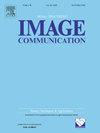基于全局和局部协同学习的无参考全方位图像质量评估
IF 2.7
3区 工程技术
Q2 ENGINEERING, ELECTRICAL & ELECTRONIC
引用次数: 0
摘要
全向图像技术在虚拟现实应用中取得了巨大的成功。随着网络带宽的不断增加,用户可以从互联网上访问海量的io。为了确保用户获得高质量的沉浸式体验,评估扭曲的视觉质量至关重要。对于大多数现有的基于视口的OI质量评估(OIQA)方法,每个视口中的不一致扭曲总是被忽略。此外,视口下采样带来的纹理细节丢失也限制了评估性能。为了解决这些问题,本文提出了一种无参考OIQA的全局-局部协同学习方法。我们采用双层学习架构来协作探索非均匀扭曲,并学习每个投影视口的稀疏表示。具体来说,我们从每个视口提取分层特征,以与人类视觉系统(HVS)的分层感知过程保持一致。通过与Transformer编码器的聚合,可以对每个视口中不一致的空间特征进行全局挖掘。为了在视口下采样过程中保留更多的纹理细节,我们引入了一个可学习的补丁选择范例。通过学习每个视口中局部纹理变化的位置偏好,我们的方法可以得到一组稀疏的图像补丁来稀疏地表示下采样的视口。综合实验证明了该方法在三个公开数据库上的优越性。代码可在https://github.com/ldyorchid/GLCNet-OIQA上获得。本文章由计算机程序翻译,如有差异,请以英文原文为准。
Global and local collaborative learning for no-reference omnidirectional image quality assessment
Omnidirectional image (OI) has achieved tremendous success in virtual reality applications. With the continuous increase in network bandwidth, users can access massive OIs from the internet. It is crucial to evaluate the visual quality of distorted OIs to ensure a high-quality immersive experience for users. For most existing viewport based OI quality assessment(OIQA) methods, the inconsistent distortions in each viewport are always overlooked. Moreover, the loss of texture details brought by viewport downsampling procedure also limits the assessment performance. In order to address these challenges, this paper proposes a global-and-local collaborative learning method for no-reference OIQA. We adopt a dual-level learning architecture to collaboratively explore the non-uniform distortions and learn a sparse representation of each projected viewport. Specifically, we extract the hierarchical features from each viewport to align with the hierarchical perceptual progress of the human visual system (HVS). By aggregating with a Transformer encoder, the inconsistent spatial features in each viewport can be globally mined. To preserve more texture details during viewport downsampling process, we introduce a learnable patch selection paradigm. By learning the position preferences of local texture variations in each viewport, our method can derive a set of sparse image patches to sparsely represent the downsampled viewport. Comprehensive experiments illustrate the superiority of the proposed method on three publicly available databases. The code is available at https://github.com/ldyorchid/GLCNet-OIQA.
求助全文
通过发布文献求助,成功后即可免费获取论文全文。
去求助
来源期刊

Signal Processing-Image Communication
工程技术-工程:电子与电气
CiteScore
8.40
自引率
2.90%
发文量
138
审稿时长
5.2 months
期刊介绍:
Signal Processing: Image Communication is an international journal for the development of the theory and practice of image communication. Its primary objectives are the following:
To present a forum for the advancement of theory and practice of image communication.
To stimulate cross-fertilization between areas similar in nature which have traditionally been separated, for example, various aspects of visual communications and information systems.
To contribute to a rapid information exchange between the industrial and academic environments.
The editorial policy and the technical content of the journal are the responsibility of the Editor-in-Chief, the Area Editors and the Advisory Editors. The Journal is self-supporting from subscription income and contains a minimum amount of advertisements. Advertisements are subject to the prior approval of the Editor-in-Chief. The journal welcomes contributions from every country in the world.
Signal Processing: Image Communication publishes articles relating to aspects of the design, implementation and use of image communication systems. The journal features original research work, tutorial and review articles, and accounts of practical developments.
Subjects of interest include image/video coding, 3D video representations and compression, 3D graphics and animation compression, HDTV and 3DTV systems, video adaptation, video over IP, peer-to-peer video networking, interactive visual communication, multi-user video conferencing, wireless video broadcasting and communication, visual surveillance, 2D and 3D image/video quality measures, pre/post processing, video restoration and super-resolution, multi-camera video analysis, motion analysis, content-based image/video indexing and retrieval, face and gesture processing, video synthesis, 2D and 3D image/video acquisition and display technologies, architectures for image/video processing and communication.
 求助内容:
求助内容: 应助结果提醒方式:
应助结果提醒方式:


